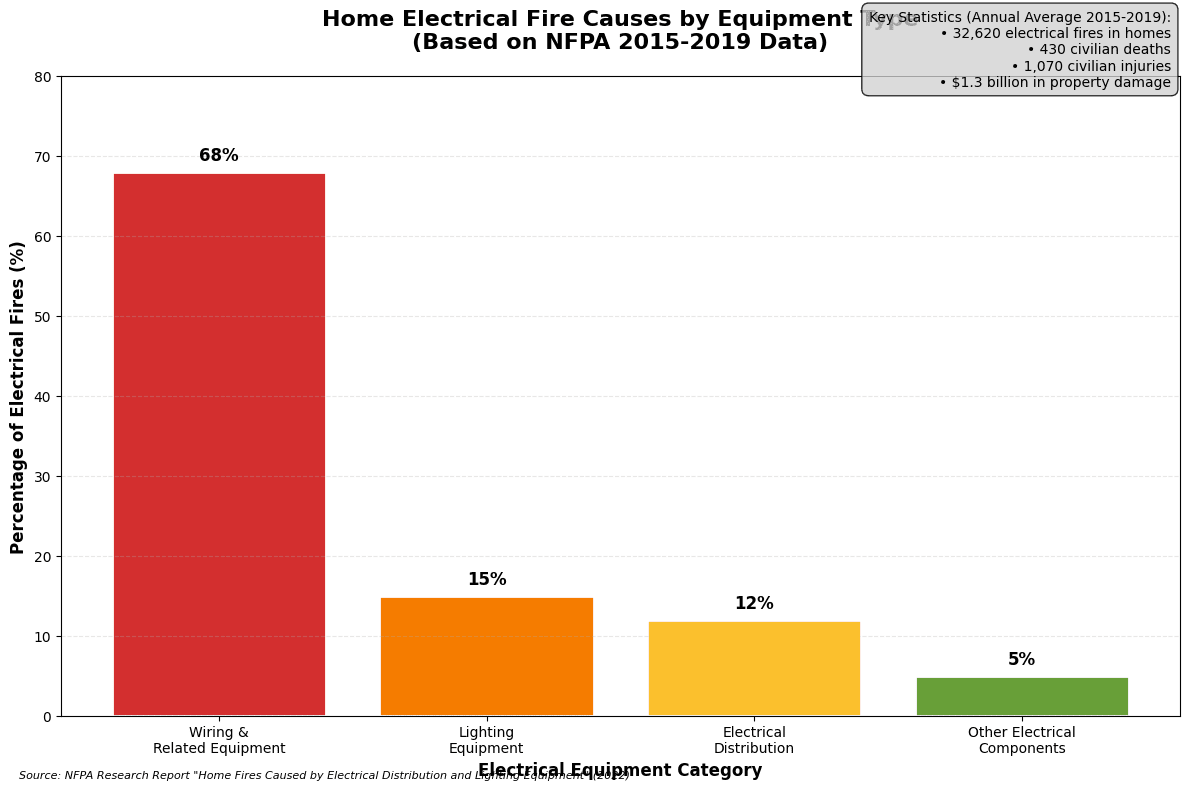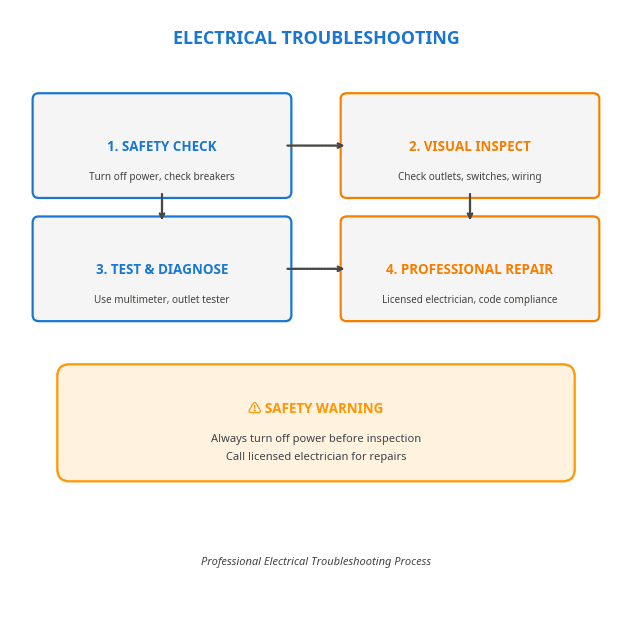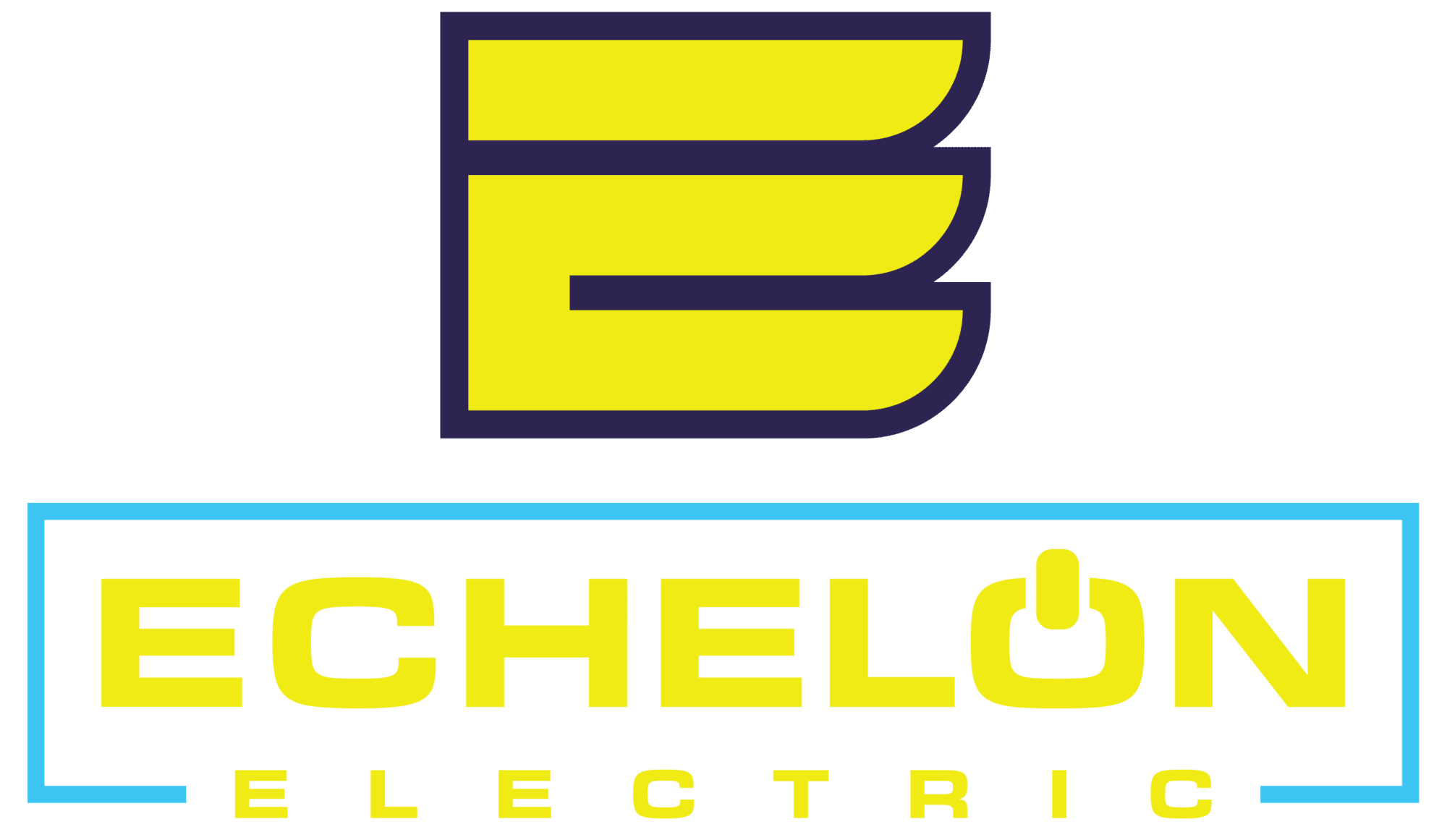Ready to find a career and not just a job? Echelon Electric is looking to expand our Team!
Working Hours:
Monday - Friday :
8:00AM to 4:30PM
Saturday & Sunday :
By Appointment Only
Home electrical systems present significant safety and performance challenges that require professional expertise to address effectively. According to the National Fire Protection Association, electrical distribution and lighting equipment cause an estimated 32,620 home fires annually, resulting in 430 civilian deaths and $1.3 billion in property damage[1]. Professional electrical troubleshooting and repair services provide homeowners with expert diagnosis of common issues including flickering lights, circuit breaker trips, dead outlets, and electrical safety hazards, ensuring both immediate problem resolution and long-term system reliability while maintaining compliance with National Electrical Code standards.
Why Professional Electrical Troubleshooting Matters in 2025
Modern residential electrical systems face unprecedented demands from increased device connectivity, electric vehicle charging, and energy-efficient appliances, creating new challenges for homeowners and electrical infrastructure. The Consumer Product Safety Commission reports approximately 31,000 electrical fires and 200 deaths annually from home electrical system failures[2]. These statistics underscore the critical importance of professional electrical troubleshooting services that can identify potential hazards before they escalate into dangerous situations.
Contemporary electrical troubleshooting extends beyond simple outlet repairs to encompass comprehensive system analysis, code compliance verification, and energy efficiency optimization. The ENERGY STAR program now offers up to $3,200 in annual federal tax credits for electrical system upgrades that improve home energy efficiency[3]. Professional electricians must navigate complex National Electrical Code requirements while addressing homeowner concerns about safety, reliability, and cost-effectiveness. Electrical failures often manifest through subtle warning signs including flickering lights, warm outlets, buzzing sounds, and frequent circuit breaker trips that require expert diagnosis to prevent more serious problems.
The integration of smart home technology, renewable energy systems, and high-capacity electrical loads has transformed residential electrical troubleshooting from reactive maintenance to proactive system optimization. Licensed electrical professionals now employ advanced diagnostic tools including digital multimeters, thermal imaging cameras, and circuit analyzers to identify issues that may not be apparent through visual inspection alone. This technological evolution requires specialized training and certification to ensure accurate diagnosis and safe repair procedures that protect both property and occupants.
Service Coverage & Options
Included Services
Echelon Electric provides comprehensive electrical troubleshooting and repair services designed to address the full spectrum of residential electrical issues. Our general repair services encompass systematic diagnosis and resolution of common electrical problems that affect home safety, functionality, and energy efficiency. Professional electrical troubleshooting begins with thorough system assessment using calibrated diagnostic equipment to identify root causes rather than merely addressing symptoms.
- Flickering lights diagnosis and repair
- Faulty outlet troubleshooting and replacement
- Circuit breaker trip investigation and resolution
- Electrical shock hazard elimination
- Warm outlet and switch repair
- Buzzing and sizzling sound investigation
- GFCI outlet testing and replacement
- Minor electrical system upgrades and code compliance
Typical Use Cases
Residential electrical troubleshooting addresses diverse scenarios ranging from immediate safety concerns to performance optimization and preventive maintenance. New electrical installations require careful integration with existing systems to prevent overloading and ensure code compliance. Replacement projects often involve upgrading outdated components that no longer meet current safety standards or capacity requirements. System upgrades focus on improving electrical capacity, adding GFCI protection, and enhancing energy efficiency through modern electrical components.
Load balancing represents a critical aspect of electrical troubleshooting, particularly in homes with increased electrical demands from modern appliances, electric vehicle charging, and smart home systems. Professional electricians analyze circuit loading patterns to prevent overheating, reduce energy waste, and extend equipment lifespan. Noise reduction and power quality improvement address issues that affect sensitive electronic equipment and overall system performance.
| Electrical Issue | Common Causes | Warning Signs | Professional Solution | Urgency Level |
|---|---|---|---|---|
| Flickering Lights | Loose connections, overloaded circuits, faulty fixtures | Intermittent dimming, lights going on/off | Tighten connections, redistribute load, replace fixtures | Medium |
| Circuit Breaker Tripping | Overloaded circuits, short circuits, ground faults | Frequent breaker trips, loss of power to areas | Load balancing, circuit repair, GFCI installation | High |
| Dead Outlets | Tripped GFCI, loose wiring, circuit issues | No power to outlet, non-responsive GFCI | Reset GFCI, rewire connections, circuit diagnosis | Medium |
| Warm Outlets/Switches | Overloading, loose connections, faulty wiring | Hot to touch, burning smell, discoloration | Immediate inspection, rewiring, load reduction | High |
| Electrical Shocks | Poor grounding, damaged wiring, faulty appliances | Mild to severe shocks from appliances/switches | Grounding system repair, wiring replacement | Critical |
| Buzzing/Sizzling Sounds | Arcing, loose connections, overheating | Audible electrical noise, sparks | Connection tightening, component replacement | High |
| Frequent Blown Fuses | Circuit overload, short circuits, aging system | Repeated fuse replacement needed | Circuit upgrade, load redistribution, panel upgrade | Medium |
Safety, Codes & Sizing Essentials
Electrical safety compliance represents the foundation of professional troubleshooting services, with National Fire Protection Association data revealing that wiring and related equipment account for 68 percent of home electrical fires and 60 percent of associated property damage[1]. Professional electrical troubleshooting must address both immediate safety concerns and long-term code compliance to protect homeowners from fire hazards, electrical shock, and property damage. The National Electrical Code establishes minimum safety standards for electrical installations, requiring licensed electricians to ensure all repairs and modifications meet current requirements.
ENERGY STAR research demonstrates that proper electrical system maintenance and upgrades can reduce energy consumption by 10-15 percent while improving system reliability and safety[3]. Professional troubleshooting services identify opportunities for efficiency improvements including LED lighting conversions, smart switch installations, and circuit optimization that qualify for federal tax credits up to $3,200 annually. Electrical sizing calculations must account for current and future electrical loads to prevent overloading and ensure adequate capacity for modern electrical demands including electric vehicle charging and smart home systems.

Equipment Category,Percentage of Fires
Wiring & Related Equipment,68
Lighting Equipment,15
Electrical Distribution,12
Other Electrical Components,5
Electrical troubleshooting requires comprehensive understanding of circuit protection, grounding systems, and load calculations to ensure safe and reliable operation. Ground Fault Circuit Interrupter (GFCI) protection has become mandatory in wet locations including bathrooms, kitchens, and outdoor areas, with Arc Fault Circuit Interrupter (AFCI) protection now required in most living areas to prevent fires caused by electrical arcing. Professional electricians must verify proper installation and operation of these protective devices during troubleshooting procedures to maintain code compliance and occupant safety.
Installation Process, Quality & Limitations
Professional electrical troubleshooting follows a systematic methodology designed to ensure accurate diagnosis, safe repair procedures, and long-term reliability. The process begins with comprehensive system assessment including electrical panel inspection, circuit mapping, and load analysis to understand the overall electrical infrastructure. Proper sizing calculations consider both current electrical demands and future expansion needs to prevent overloading and ensure adequate capacity for modern electrical requirements.
The troubleshooting process proceeds through four distinct phases: safety assessment with power isolation and circuit breaker verification, visual inspection of outlets, switches, and visible wiring for signs of damage or wear, testing and diagnosis using calibrated instruments including digital multimeters and circuit analyzers, and professional repair by licensed electricians ensuring code compliance and system integrity. Each phase requires specific expertise and equipment to identify problems accurately and implement appropriate solutions.

Quality electrical troubleshooting requires recognition of system limitations and potential complications that may affect repair scope and cost. Older homes often present challenges including outdated wiring methods, insufficient grounding systems, and electrical panels that no longer meet current code requirements. Undersized electrical service may require utility coordination and significant infrastructure upgrades to support modern electrical loads. Concealed wiring problems can necessitate exploratory work and drywall repair that extends project scope beyond initial estimates.
Case example: A homeowner experiencing frequent circuit breaker trips in the kitchen discovered that the 20-amp circuit serving multiple high-wattage appliances was overloaded during peak usage periods. Professional troubleshooting revealed that the existing circuit could not safely support the electrical demands of a microwave, toaster oven, and coffee maker operating simultaneously. The solution required installing an additional dedicated circuit for high-wattage appliances, but limitations included the need to route new wiring through finished walls and upgrade the electrical panel to accommodate the additional circuit breaker. Potential risks included temporary power disruption during installation and the possibility of discovering additional code violations requiring correction during the upgrade process.
Action Plan
Homeowners can take several preparatory steps to facilitate effective electrical troubleshooting while maintaining safety protocols and gathering useful diagnostic information for professional electricians. Begin by documenting electrical problems including specific symptoms, frequency of occurrence, and any patterns related to time of day or electrical usage. Create a simple map of your home’s electrical circuits by testing which outlets and fixtures are controlled by each circuit breaker, as this information proves invaluable during professional diagnosis.
Measure room dimensions and identify electrical loads in areas experiencing problems, noting the wattage ratings of appliances and devices that may contribute to circuit overloading. Check electrical panels for proper labeling and note any circuit breakers that trip frequently or feel warm to the touch. Inspect visible outlets and switches for signs of damage including discoloration, burning odors, or loose connections, but avoid touching or manipulating electrical components beyond visual observation.
Establish noise tolerance goals if electrical buzzing or humming sounds are present, as professional electricians can recommend solutions based on acceptable sound levels measured in decibels. Verify that GFCI outlets in bathrooms, kitchens, and outdoor areas function properly by pressing the test and reset buttons monthly. Check ductwork and wiring paths in basements and attics to identify potential routing options for new circuits or repairs, noting any obstacles that might affect installation complexity.
Schedule a comprehensive electrical evaluation with licensed professionals when warning signs appear or when electrical systems have not been inspected within the past ten years. Professional assessment provides accurate diagnosis, code compliance verification, and cost-effective repair strategies that address both immediate problems and long-term electrical system reliability. Contact qualified electrical contractors who maintain proper licensing, insurance coverage, and experience with residential troubleshooting and repair services.
For immediate assistance with electrical troubleshooting and repair services, contact our licensed electricians who provide comprehensive diagnostic services and code-compliant solutions for all residential electrical issues. Our team offers transparent pricing, detailed explanations of recommended repairs, and ongoing support to ensure your electrical system operates safely and efficiently. Schedule your electrical evaluation today to address current problems and prevent future electrical hazards.
Future Outlook
The residential electrical troubleshooting landscape continues evolving with smart home integration, advanced diagnostic technologies, and enhanced safety systems that require specialized expertise and updated training for electrical professionals. Smart electrical controls including programmable switches, automated circuit protection, and remote monitoring systems provide homeowners with unprecedented visibility into electrical system performance while creating new troubleshooting challenges that require understanding of both traditional electrical principles and digital communication protocols.
Electronically Commutated Motor (ECM) technology and variable frequency drives are becoming standard in HVAC systems, appliances, and other electrical equipment, offering improved energy efficiency but requiring specialized diagnostic equipment and training for proper troubleshooting. These advanced systems can reduce energy consumption by 20-30 percent compared to traditional motors, but their complex control circuits and communication interfaces present new failure modes that traditional electrical troubleshooting methods may not address effectively.
Indoor air quality integration with electrical systems creates opportunities for comprehensive home performance optimization through coordinated HVAC, lighting, and ventilation controls that respond to occupancy patterns and environmental conditions. However, these integrated systems require careful attention to electromagnetic interference, proper grounding, and communication protocol compatibility to prevent system conflicts and ensure reliable operation.
Emerging risks include cybersecurity vulnerabilities in connected electrical devices, compatibility issues between smart home systems from different manufacturers, and the need for regular software updates that may affect electrical system operation. Code updates continue addressing these technological advances, with recent National Electrical Code revisions including requirements for surge protection, energy storage systems, and electric vehicle charging infrastructure that electrical professionals must understand and implement correctly. Poor installation practices or inadequate system integration can compromise both safety and performance, emphasizing the continued importance of professional electrical troubleshooting services that combine traditional expertise with modern technological understanding.
Key Takeaways
- Electrical distribution and lighting equipment cause 32,620 home fires annually with 430 deaths and $1.3 billion in property damage, emphasizing the critical importance of professional troubleshooting services[1]
- Wiring and related equipment account for 68 percent of electrical fires and 60 percent of associated property damage, making systematic wiring inspection essential for home safety[1]
- ENERGY STAR electrical system upgrades qualify for federal tax credits up to $3,200 annually while reducing energy consumption by 10-15 percent through improved efficiency[3]
- Professional electrical troubleshooting follows a four-phase process including safety assessment, visual inspection, testing and diagnosis, and code-compliant repair by licensed electricians to ensure system reliability and occupant safety
References
- Campbell, Richard. “Home Fires Caused by Electrical Distribution and Lighting Equipment.” National Fire Protection Association, February 1, 2022. https://www.nfpa.org/education-and-research/research/nfpa-research/fire-statistical-reports/home-fires-caused-by-electrical-distribution-and-lighting-equipment
- U.S. Consumer Product Safety Commission. “Electrical Safety.” CPSC Safety Education. https://www.cpsc.gov/safety-education/safety-guides/home/electrical-safety
- U.S. Environmental Protection Agency. “ENERGY STAR Home Improvement Savings.” ENERGY STAR Program. https://www.energystar.gov/homesavings

